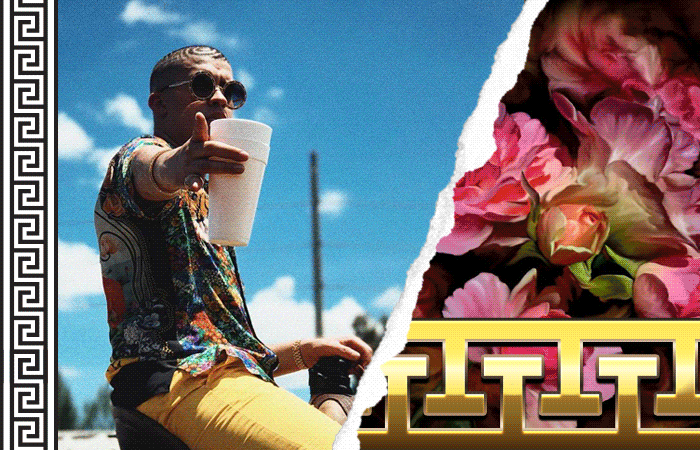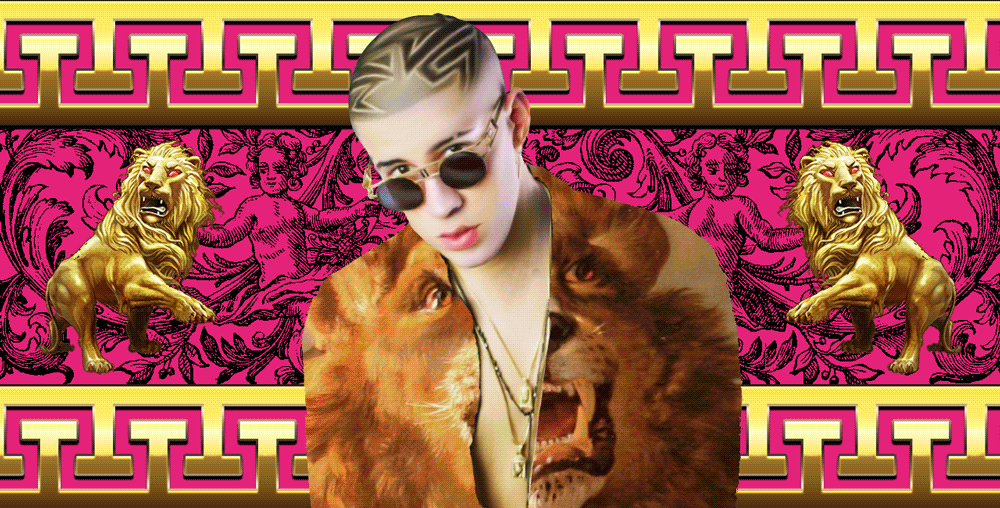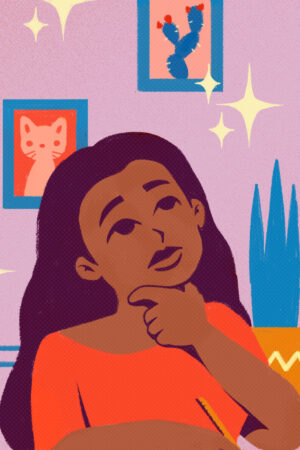One year ago, there were no rappers wearing yellow nail polish with high-water tuxedo pants at Premios Juventud, much less canary bike shorts in beachside glamour shots. But in the first half of 2016, the era of Bad Bunny had not yet begun. These days, it’s doubtful that there are many urbano fans unacquainted with the Puerto Rican trap en español singer’s pounding baritone, head of impressive shaved designs, and eclectic designer wardrobe that adds a distinctly “fashion” swerve on the genre’s traditional macho styling. Buoyed by DJ Luian and his powerhouse Puerto Rican label Hear This Music, plus a parade of high-ranking cosigners from Arcángel to J Balvin, Bad Bunny’s saturation of the scene in 2017 is startling for an artist who has yet to announce plans for a debut album. Most importantly, his particular brand of success is a strong omen of what the next years will bring for the Latin music industry.
Bad Bunny’s (aka Benito Antonio Martínez Ocasio) story ignited last January with a “prende otro phillie bebé.” It was the first line of the 23-year-old vocalist’s track “Diles” which, according to DJ Luian, caught the attention of Hear This Music after it had already garnered a million plays on Ocasio’s SoundCloud page. “Dice que le gusta hacerlo con mis temas de trap,” he croons, an addictive beat cradling husky assertions of his sexual prowess. The DIY track’s success convinced Hear This Music that their young artist’s breakout moment had arrived. They stacked a “Diles” remix with multiple generations of urbano heavyweights — emergent reggaetonero Ozuna alongside established ones like Arcángel, Farruko, and Ñengo Flow. The broad show of force established Bad Bunny’s versatility; he had the blessing of giants, yet was himself part of el género’s new wave. Listeners fell hard, the lyric video for “Diles” alone racking up over 320 million YouTube views and anointing Bad Bunny as Latin trap’s new featured vocalist of choice.

It was the start of a heavy run. Bad Bunny’s cutting, luxe-voiced lyrics — aided no doubt by his artful pout, video charisma, and parade of fanciful wardrobe choices — captured fans’ attention and even inspired impersonators. In the year after “Diles,” he’s churned out viral singles featuring a universe of hitmakers from Karol G to Nicky Jam on a near weekly basis. Bad Bunny currently clocks in at 5.7 million monthly Spotify listeners. He has over a billion views on YouTube, the latter of which has played an important role in distribution for many Puerto Rico’s trap artists, especially ones like Anuel AA, who have found their content banned from the radio for explicit lyrics.
Bad Bunny’s second hit “Tu No Vive Así” paired him once again with Arcángel for a trap-slung anthem, which in turn set the stage for Bunny’s first massive solo moment, the pitch-black musing “Soy Peor.” That tale of love gone rancid reads as Bad Bunny’s trapero-player origin story, and helped fuel his reputation for heartfelt if twisted romanticism. It garnered a phalanx of response videos, including the clapback put out by vocalist Lady Lauudy. She was dubiously identified as Bunny’s ex in a thousand reaching YouTube comments — credit fans’ eager theories to the fact that actual details about Bunny’s personal life are kept on a tight leash.
Ocasio grew up in the PR beach community of Vega Baja with his parents and two younger brothers. After receiving a Vico C album for Christmas in one of his earliest memories, he says he started singing, songwriting, and producing at 13, counting among his inspirations Héctor Lavoe and Michael Jordan. Bad Bunny reportedly came up with his artist name from a photo of him as a first grader on Easter, looking malevolent in a pair of bunny ears he had been forced to wear. The gag, as he told Keiry Narvaez in her En La Intimidad video interview series, is that “bunnies are sweet; I’m sweet.” Ocasio studied communications at the University of Puerto Rico’s Arecibo campus before getting his family’s blessings to focus on music. This pivot paid off — Ocasio reportedly first caught DJ Luian’s eye while he was still performing at small San Juan shows and posting videos of himself singing on Instagram. So fresh is Bad Bunny’s fame, he spent a few moments before performing at this year’s Premios Juventud reminiscing to fans that in 2016, he had to race home from his job at a grocery store to catch the televised awards show.
“My goal is for trap to stabilize and for it to be given the space it deserves in the media.”
In early 2017, Ocasio linked with J Balvin, the crossover star of reggaeton whose Energía LP showed the lengths at which dancehall, reggaeton, and Latin trap could be spliced with pop’s current tendencies to produce addictive, globally popular hits. Their first collaboration “Si Tu Novio Te Deja Sola” was just that, with Bunny’s trap tendencies re-spun by a cha cha bop. The two artists romped in sherbet-colored two-piece looks and rose-embroidered denim in the music video, Balvin’s neon locks a fair match to Bunny’s artistically carved cranial crop circles. Before Ocasio embarked on his North American and European tours, the two found a moment to perform the hit live at the Latin Billboard Awards, a solid presentation to the international crowds to which Balvin has explicitly decided to direct his career since Energía dropped a year ago.

Today Bad Bunny is one of the most sought-after artists in his genre, and he’s also making waves far outside the world of reggaeton and Latin trap. Rapper Meek Mill posted a video of himself singing along to “Soy Peor,” seemingly unaware of the Ocasio line “y están como Meek Mill sin batería” on “Tu No Vive Así.” But even as the music industry turns into a rabbit’s warren, many have wondered what Bad Bunny’s success means for Latin trap in terms of genre integrity. In a January interview with Rapetón, Arcángel opined, “Trap is not romantic music. [Today’s artists are] making good R&B with a trap beat. Trap music is music that comes from the trap house…We’re calling everything trap that doesn’t have reggaeton’s beat.” The challenge to Bad Bunny’s breakup trap was clear. But Arcángel’s concerns appeared to take a backseat to his business sense when a few weeks later he released “Me Acostumbré.” The creeping track featured none other than El Conejo Malvado, who fades out of the song asserting not just his participation in, but his leadership of the current trap movement: “Oye, díselo qué la corona del trap la tenemos nosotros.”
Traditionalists familiar with Anuel’s hardcore tendencies may find room to question Bad Bunny’s emphasis on love scorned in many of his lyrics. But given the varied evolutions of the genre currently taking place in Latin America, it’s a rough time to be a trap purist. Practically speaking, it appears that there’s no schism that Bunny’s upward trajectory can’t dispel. After rumors of a potential rivalry between him and the incarcerated Anuel churned, Bunny posted an honorific Instagram tribute to the emcee. Their teams quickly turned the situation into an opportunity for collaboration. In May, the duo released their first track together. “La Última Vez,” to the surprise of any fans awaiting a street anthem, turned out to be a Spanish-language redux of Justin Bieber’s “Love Yourself,” complete with a scratchy jailhouse recording from Anuel.
“People love to put a name on this — [but] I make music,” Bad Bunny said. “Trap used to be a concept, a lifestyle. Unfortunately nowadays you can search a music site for trap and 100 different songs come up, with a certain kind of beat. Trap is defined by a beat, you know?” He’s the commercial edge of Latin trap, and given his current trajectory, seems to have plans to take that beat as far as he can into the realm of popular culture. “My goal is for trap to stabilize and for it to be given the space it deserves in the media, without having to be censored,” the vocalist once said.
“People who didn’t know Spanish were singing my songs. It was something incredible.”
His photogenic presence, rich vocal bassline, and swagger made him an excellent draft to Hear This Music, a label that had already experienced more than its share of mainstream Latin trap success. Last year, the production house deployed “La Ocasión,” a seductive, 808-employing hit featuring De La Ghetto, Ozuna, Arcángel, and Anuel. That song’s success led Anuel to announce on Facebook, “In the history of trap, there’s never going to be a song more cabrón than ‘La Ocasión.’”
The firm was no doubt on the lookout for an artist to encapsulate the new hybrid sound, and who could capitalize on urbano fans’ fever for all things trap. In Bad Bunny, they found a talented vocalist and an emcee with a healthy respect for urbano predecessors, who could marshal on-point cultural references that speak to Latino hip-hop fans. “No tengo cuatro babys, tengo 23 como Mike,” he raps on Karol G’s cautionary tale for internet stalkers “Ahora Me Llama,” the words a nod to Maluma’s oddly controversial anthem “Cuatro Babys” and MJ’s beloved jersey number from the player’s Bulls era. On “No Te Hagas,” he makes a cheeky reference to Puerto Rican beauty queen (and Residente’s former boo) Denise Quiñones. “Tú extrañas este bicho como Denise extraña el de René.” Now that the Bad Bunny experiment has paid off, Hear This Music is intent on getting due credit. “Bad Bunny is my artist, mine, mine,” announced DJ Luian late last year. “I make the decisions, me, and if I don’t want something, that’s it!”

Arcángel is right to point out that today’s Latin trap isn’t coming to listeners straight from the trap house, but it’s unclear who, if anyone, cares. In the U.S., the term has long been used to referred to Flosstradamus and Baauer-style EDM, a strange hybridization that music journalist David Drake called “an unnecessary, insecure and ahistorical crossing of wires” way back in 2012. Given the black Nuyorican role in the creation of hip-hop, it makes sense that PR artists like Ozuna and Bryant Myers would be at the forefront of the trap industry’s evolutions in Latin American countries.
Narrative and identity as a definition of the genre has been tossed aside by many mainstream Latino artists, from Farruko, Fuego, and Noriel to more emergent voices like Spain’s Los Santos (formerly PXXR GVNG) and experimental producers à la Argentina’s CL∩B H∀TS, who have begun applying trap’s distortion and darker flows to themes that have little to do with drug dealing-induced ennui and anxiety coming from Atlanta. The change goes beyond what you hear — the fact that Bad Bunny and other light-skinned artists are becoming best sellers in a genre pioneered by black vocalists and producers is another salient (and controversial) feature of trap en español’s recent history.
But perhaps the biggest test that Ocasio now has to face may come from questions about his strength as a solo artist. He’s built a fanbase from collaborations with the biggest names in the urbano industry, but only time will tell what happens when Bad Bunny is the only name on the lineup. “Tu No Metes Cabra,” his most recent single, is only Ocasio’s third widely released solo track. Its hook borrows from Hector El Father’s “Noche de Travesuras,” a classic reggaeton track from 2004 that like the fateful “Diles” remix, plays as a savvy nod by Ocasio to the genre’s roots, this time refreshed with Bunny’s flair for pop culture references. In this case, it’s packed with more sports nods (“Shaquille O’Neal debajo del aro/Nadie me quita un rebote”) and an albeit politically questionable 45 reference (“En el VIP soy Donald Trump.”) Who knows if Bad Bunny’s trajectory will follow feature artists who have soared on their own wings or lost steam once in the spotlight, but given his standout lyrical skills and talent for upstaging costars in video clips, time appears to be on his side.
“People love to put a name on this — I make music.”
The amalgamation practiced by Bad Bunny and his peers has turned out to be a hit with international audiences. He’s releasing a clothing line by the end of the year and has upcoming collaborations rumored with kingpins of the Latin pop world, manna to the studio execs who are thirsty for the world’s next Daddy Yankee supernova crossover moment. “I had a show in Rome, in the south of Italy, where the language is obviously not Spanish,” Bad Bunny once explained in a Canadian talk show. “But the people who didn’t know Spanish were singing my songs. It was something incredible, something that made me go, ‘Wow, we’re doing things well, making good music for another culture, another language to get involved in the movement.’” His trap movement may not look the same as that of the genre’s pioneers, but fans seem content to see things El Conejo Malvado’s way for the next few bars.







